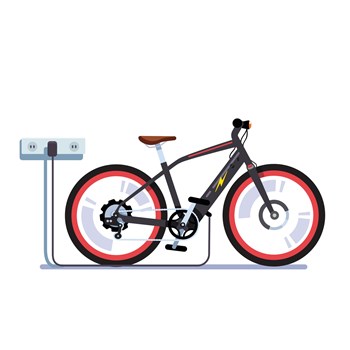
All over the news, from coast to coast, reports of fires and explosions caused by lithium-ion batteries describe blazes that are out of control, difficult to extinguish, and excessively smokey. Tragically, many have resulted in fatalities and serious injuries, and certainly all have caused extensive damage to properties and the environment.
But the number of devices that are powered by rechargeable batteries and their prevalence in communities—particularly within homes and multifamily buildings—continue to increase. Undoubtedly, such devices offer benefits that are essential to today’s society: convenience, speed, portability, and reliability. And under normal conditions, say experts, lithium-ion batteries are safe. On the other hand, their improper use, maintenance, and storage can have enormously destructive consequences—and boards, managers, and even legislators are struggling to figure out if and how to use rules, education, and laws to prevent such disasters.
What Is a Lithium-Ion Battery?
According to the Clean Energy Institute, lithium-ion (Li-ion) batteries are the predominant commercial form of rechargeable battery, widely used in portable electronics and electrified transportation—everything from e-cigarettes to Teslas. They differ from single-use, disposable batteries—also known as primary batteries—in that they accumulate and store energy through a reversible chemical reaction, which is achieved by applying an external source to the chemical substances. In other words, you plug them into an outlet.
Compared to other rechargeable sources of power, Li-ion batteries have high energy densities and long lifespans, which makes them ideal for applications like laptops and mobility devices. However, Li-ion batteries also have a tendency to overheat, and can be damaged at high voltages.
“Since most Li-ion electrolytes are highly flammable,” says the Clean Energy Institute’s website, “damaged and overheated batteries can experience thermal runaway and combustion. Li-ion batteries are also subject to aging, meaning that they can lose capacity and frequently fail after a number of years.”
This high propensity for conflagration has made the transport and storage of Li-ion batteries and the devices they power extremely problematic for buildings and communities nationwide.
Are Li-Ion Batteries Regulated?
According to several industry professionals contacted for this article, there is no legislation regarding Li-ion devices at either the federal or state levels. Local legislatures and authorities have been more proactive, however—particularly in the New York metropolitan tri-state area where just in the last year there have been several fatal fires caused by e-bikes in and around residential buildings—but most have steered away from all-out bans.
According to Steve Mlenak, an attorney in the Iselin, New Jersey, office of law firm Greenbaum, Rowe, Smith & Davis, “Some localities have moved to prohibit [Li-ion batteries], especially in Bergen County—Englewood Cliffs and Edgewater, for instance. The trend is spreading throughout the state,” he says, noting that a bill was introduced in the legislature this summer that would prohibit the sale of certain lithium-ion devices; restrict the sale, lease, or rental of certain bicycles and scooters; and create a fire-risk-awareness campaign.
Such proposed legislation follows in the footsteps of similar regulations adopted in New York City. Stephen H. Orel, an attorney with the Manhattan-based law firm Schwartz Sladkus Reich Greenberg Atlas LLP, says that to date, “The New York City Council has passed five measures dealing in some way with lithium-ion batteries in mobility devices. These bills went from introduction to passage in only four months with virtually no opposition. One prohibited sale of reconditioned used lithium-ion batteries; another banned sale of said batteries unless they had been listed by a nationally recognized testing laboratory such as UL, or other approved organization.”
“What they have not done,” says Jeffrey Reich, another Schwartz Sladkus Reich Greenberg Atlas attorney, “is ban the bikes and scooters from the interiors of residential buildings or commercial buildings, which is really the type of protection that would, I think, best serve co-op and condominium communities and rental apartment communities. And from what I understand, it’s very unlikely that the legislature would ever do that, because the City Council doesn’t want to negatively impact people who rely on these types of electric vehicles economically. So that’s what we’re up against.”
The “we” to which Reich refers are the decision makers in condos, co-ops, and other multifamily communities who want to protect their residents, staff, visitors, and properties from the dangers posed by Li-ion battery fires. The legislation goes as far as mandating various educational and reporting requirements for New York City apartment building owners—including boards of co-ops and condos. By April 30, 2023, they all must distribute a four-page, full-color FDNY pamphlet to all building residents and staff which outlines and explains the dangers of e-bikes and other items that depend on lithium-ion batteries for power. It can be accessed and downloaded here: https://www.fdnysmart.org/wp-content/uploads/2021/12/FDNY-Lithium-Ion-batteries-060321-05.pdf
What Can Boards Do on Their Own?
“Right now,” says Mlenak, “regulating battery storage inside units is specific to board authority, but they can regulate it on common area property—like a bike storage area, for example.” Beyond that, he continues, “it depends on how the bylaws are written, and whether they provide the association with the authority to regulate inside units.”
Since it is normally within a board’s authority to amend house rules, and in the absence of city, state, or federal laws to the same effect, “boards should start with regulations in common areas and go from there,” says Mlenak. “Anything more than that might require an amendment of bylaws,” which would be subject to a shareholder or member vote in accordance with the building’s or community’s specific governing documents.
In his experience, Reich has seen boards go in various directions addressing the issue of Li-ion batteries. “We have many co-op buildings that have adopted house rules—or in condos, rules and regulations—banning the storage of lithium-ion batteries, or the storage and charging of them in the building,” he relates. “We have some buildings that have outright banned scooters and the like. And we have others that have said you could bring the scooter or the bike in, but without the battery. And then we have some buildings that just haven’t done anything about it, and are either ignorant to the issue or are hoping that the city takes some action that obviates the need for them to take their own action.”
Reich goes on to note that any ban or storage regulation would not be able to apply to mobility devices that are necessary for handicap accessibility, such as battery-powered wheelchairs and rascals. “But,” he adds, “at least anecdotally, I’m not aware of any fires having been caused by these types of devices.”
Jake Wark, public information officer for the Massachusetts Department of Fire Services, says that without a legislative solution, education is key to keeping buildings and communities safe. He lays out some commonly understood ways to minimize the potential hazards that lithium-ion batteries pose at home.
“First and foremost,” he says, “every family should have working smoke alarms and carbon monoxide alarms on every level of their home. We recommend checking the manufacturing date printed on the back of your alarms twice a year when you change your clocks. Smoke alarms should be replaced after 10 years and CO alarms should be replaced after 5 to 7 years, depending on the model. If it’s time for a replacement smoke alarm, choose one with a sealed, long-life battery and a hush feature. Choose photoelectric alarms from a well known national brand. It’s also important to know two routes out of your home and practice those routes so you’ll remember them in an emergency.
“Changing construction practices, open floor plans, synthetic furnishings, and other factors mean that a fire at home can become deadly in three minutes or less,” Wark warns, “so working alarms and a practiced escape plan can literally be the difference between life and death.”
In terms of lithium-ion batteries specifically, “We’ve seen residential fires start with items as small as e-cigarettes and as large as e-bikes,” Wark continues. “The most common scenarios include overcharging the devices and using generic or aftermarket charging equipment, so we strongly recommend using the charging equipment that came with your device. Plug it directly into a wall outlet, not an extension cord or power strip. Charge the device (or the battery, if it’s charged separately) on a hard and stable surface like a table, not a bed or couch. Don’t toss clothes, bedding, or other combustible materials on it. It may be tempting to leave your phone or laptop charging overnight while you sleep, but it’s much safer to do this while you’re awake and in the room. Disconnect the device when it’s fully charged.”
Wark goes on to advise that “lithium-ion batteries are best charged, stored, and used at room temperature. That’s not hard at home as long as you keep them out of direct sunlight, but it’s worth a reminder not to leave phones, laptops, and other rechargeable devices in a car on a hot day. With regard to scooters and e-bikes in particular,” he says, “store these large devices outdoors if possible. If you must store them indoors, keep them away from doors, windows, and stairways. Always keep these routes clear so you can escape—and firefighters can enter—in an emergency.
“Finally, with regard to disposal, lithium-ion batteries should not be discarded in the trash. Recycling is the best option, and you can find a location to take them at https://www.call2recycle.org/locator/.”
Ripped From the Headlines
On a recent weekend, a three-alarm fire broke out in a Sunset Park, Brooklyn, storage facility, where fire officials discovered 300 e-bikes and other ‘micro-mobility’ devices crammed into two units. The flames from three bikes that had ignited were too much for the facility’s sprinkler system—which did function as intended—to handle. It was only the quick response of FDNY and the copious amounts of water they used that finally contained the conflagration, but not before a firefighter suffered smoke inhalation that sent him to the hospital.
FDNY assistant chief Michael Meyers told news outlet NY1 in its coverage of the story, “When the fire suppression systems were designed a long time ago, no one had e-bikes or e-batteries in mind. So what happens is these fire suppression systems are not designed to put out enough water” to handle the fires that result from electronic mobility devices. “Thank God for the fire department and the great work of Engine 241 and Ladder 109 coming in here and getting on this right away,” he continued.
The department told NY1 that this year alone, through October 16, e-bikes were responsible for 214 fires that caused 116 injuries in New York City.
Darcey Gerstein is Associate Editor and a Staff Writer for New England Condominium.









Leave a Comment